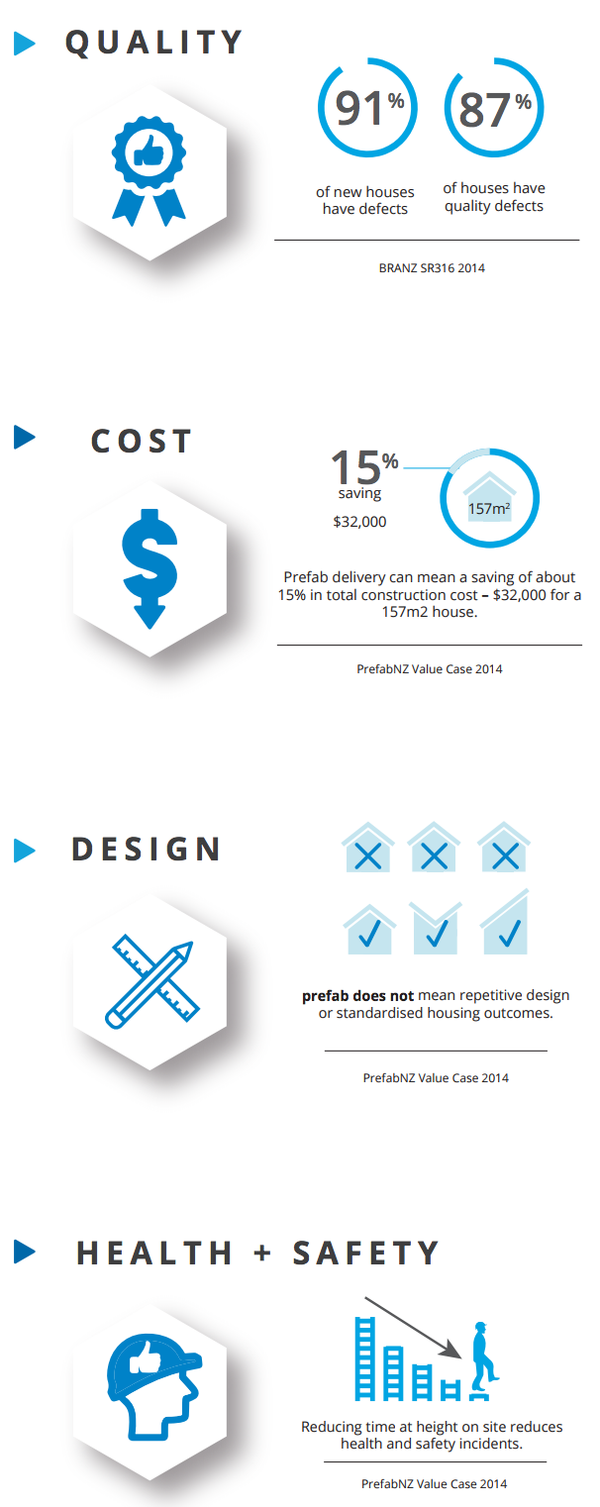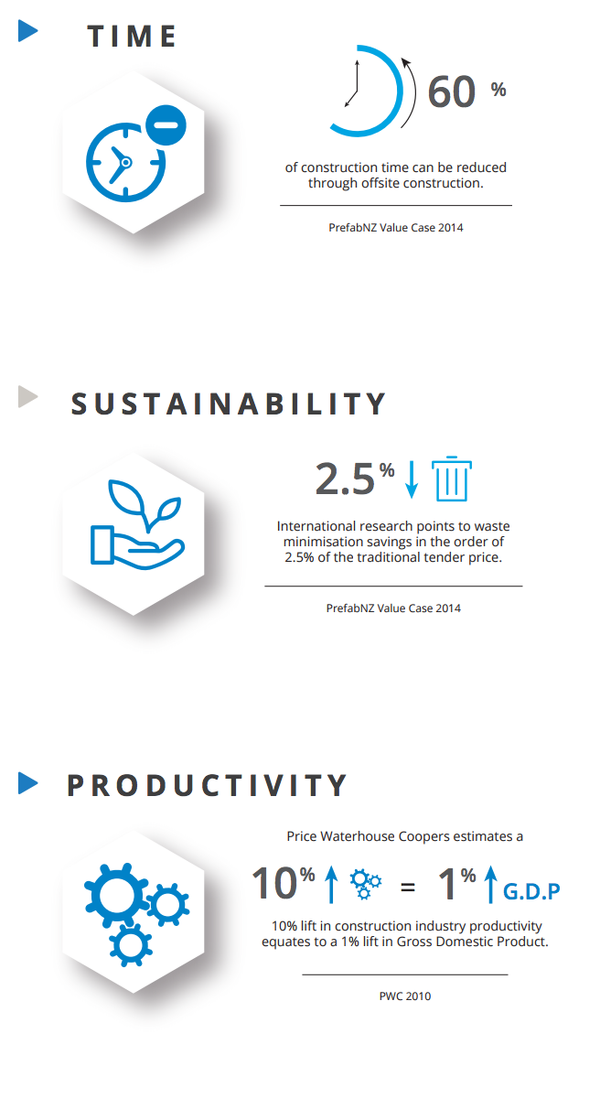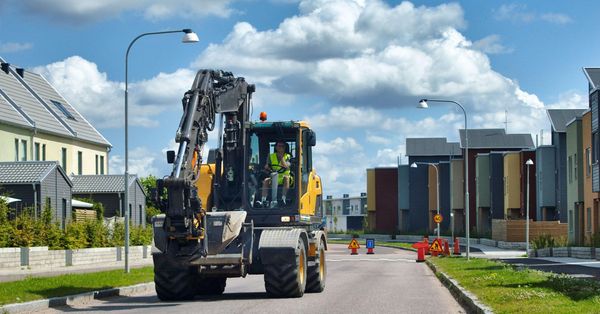
Kathryn Ryan: Can we address the housing shortage by ramming up construction of prefabs? It’s predicted that the country will need 100,000 new homes by 2030, 70,000 of them in Auckland.
Last week, it was reported that Fletcher Living has built a 170 square metre house in just nine and a half hours at Auckland’s Hobsonville Point made largely of panels constructed off-site and put together on-site.
The prefab industry has, for years, been pushing the benefits of off-site component manufacture. The industry body, PrefabNZ, says prefab houses are 60% quicker to build, cost 15% less, have fewer defects than traditional builds, and are more sustainable.
As Chief Executive Pamela Bell says, currently, 2% of complete buildings are fabricated, but it’s predicted to be 20% within 10 years. Pamela’s here in our Wellington studio. Good morning.
Pamela Bell: Good morning.
Full Audio Interview (transcription below):
Prefabrication (prefab), also referred to as offsite construction, comes in all shapes and sizes, from small components to two-dimensional panels, three-dimensional volumes/modules, a hybrid of several systems or a complete building. It can be made up of any material, from timber to concrete, metal, plastic or a combination.
International reports have extolled prefab’s virtues as a valuable part of the built environment, saving time, waste, being better quality, lower risk.
Kathryn Ryan: Nine and a half hours to build a house. It really does capture the imagination, doesn’t it?
Pamela Bell: Absolutely. Look, the time on-site can really be reduced, which is great for the people working on the site. Health and safety is greatly improved because in a manufactured environment you can build at scale height components at low heights.
So a roof can be made on the floor, and then you can reduce the risks to the workers at site. So there’s a huge number of benefits, but health and safety was one missed off their list.
Kathryn Ryan: And most of these panels, of course, are constructed off-site, so you had to add that time to the building. But overall, is it still going to be quicker than the traditional way of building?
Pamela Bell: Yes. The build time for the structure is reduced, and it can be reduced 50 to 60 percent, as we see it at site. And this does mean that there is, of course, manufacture previously and pre-planning.
One of the beauties of using off-site construction is that you actually have to pre-plan and think about what you’re doing. There’s not a lot of last minute decisions, which is what often leads to time delays in traditional construction.
Kathryn Ryan: Well, I listed lots of benefits. You’ve added a few more. Why then hasn’t it caught on?
Pamela Bell: Well, there’s lots of really interesting reasons for that, and one of them is quite basic, which is really just that we’re actually quite happy with the status quo.
There’s an aversion to risk and to doing new things when, actually, we’re making quite good profits the way we operate at the moment with the traditional building sector.
The really heartening news is that there are a large number of people looking and involved in prefabricated building. Our membership of PrefabNZ, for the last seven years, we’re at about 250 organizations, and some of these have been doing prefabricated means for over 15 years.
For example, the Chateau Tongariro was made with an entire wing made of volumetric boxes or rooms. So we really have been using these advanced methods of construction for some time, but we do need to ramp up if we’re going to meet the housing supply needs that New Zealand has.
Kathryn Ryan: Can we ramp up? Because all we’re hearing is that we have shortages. You still need, of course, the manufacturers those to build off-site. I mean, how quickly could prefabs ramp things up?
Pamela Bell: Well, we do have a number of manufacturing facilities. We have, for example, Concision in the South Island, making panels. Stanley Modular in the middle of the North Island making panels and volumetric boxes.
We are delivering almost all of our new build houses using components, of course. Pre-nailed roof trusses and wall frames. We have some latent capability. We have capacity to improve, and we have a number of new projects and new businesses coming online as we speak.
A lot of interest in investment from offshore. We did a recent trip to Sweden and looked at their methods. They are some of the world leaders in timber-based panel and volumetric building, and they build multi-family homes like this all the time.
There are some really great established industries in Sweden, Germany, Austria, and Japan–

Kathryn Ryan: So we have a lot to learn?
Pamela Bell: We have a lot to learn. They have been going for 60 years. We’re nearly there. What we are missing is a visible demand. We need the client who can put the money down and say, “I want several hundred of these houses, and let’s push the button.”
Kathryn Ryan: So nothing in that area quite yet?
Pamela Bell: Well, there is a lot of potential for Housing New Zealand and for large government clients to be more active in this area.
Kathryn Ryan: And they’re more likely to be your clients, do you think, than the private industry?
Pamela Bell: Private industry can do this as well. It’s just a matter of writing the cheque.
Kathryn Ryan: I wonder if part of the problem is that word prefab. It has an image problem. Let’s be honest, you almost need a new phrase for it, don’t you?
Because I think of prefabs as those funny little boxes that are taken into schools, used for a little while, and then got rid of. I mean, do we need new terminology?
Pamela Bell: There are a number of interchangeable terms of site construction, modern methods of construction, innovative construction. You’re absolutely right that people use different terms.
Some people use modular, which really means a box form or a volume. Some of the things that you sometimes see on Grand Designs, for example, which is a great way to beam these innovative construction methods into our living rooms.
You’re right that a lot of people have historical misperceptions, myself included. I went to school in what we term a prefab, which was light, flimsy, temporary.
So it was made for a short-term purpose and always used well past its use by date. So we can talk about innovative construction if you’d like.
Kathryn Ryan: I think that’s a bit sexier, actually, I must admit. What about new technologies, too? What about 3D printing? So much talk these days that the future of building is going to be 3D printing on-site.
Pamela Bell: You’re absolutely right, and there are a number of international reports from McKinsey Global, KMG, PWC, and the World Economic Forum that all point to low productivity in the construction industry.
We’ve got a long way to go to catch up with manufacturing if you look at the way our yacht building industry works, for example.
So construction industry is very low in the take up of these types of technologies, but there’s huge potential for visual reality, augmented reality, 3D printing, you name it.
One of the ones that we talk about very often, which is actually now law, regulated, mandated in the UK since 2016 for government projects is the use of BIM, which is an acronym for Building Information Modelling.
Which basically means that not just the building structure is in a computer file, but also the costs, the supply, all the electrical and plumbing, and services are all in this one digital model, which then carries on and has a life into maintenance services, which is extremely useful.
So the future of BIM is very much linked to the future of innovative construction.
Kathryn Ryan: Pamela, you were talking about this, if you really want to wrap things up, having a big order. But this is the other problem with that phase prefab, in a way, and that little– I’ve got this little song, Little Boxes on the Hillside happening in my head.
Within the prefabrication area, is there room for individuality? Because, really, that’s what we want as well, don’t we?
Pamela Bell: Yes, of course. So off-site construction or innovative construction has five types, which goes right down to the pre-nail roof truss and wall frame components, small scale. And as we know, no two houses built like that are generally alike.
Panels, I mean, you can end up with any architectural design form. Volumes, boxes, again, there’s a huge amount of flexibility. Even transportable houses, I think you’ll find that even an extremely well-established firm like Lockwood has never actually built two houses alike.
The same with Keith Hay Homes. They’ve been in business for over 70 years, and they’ve never built two that are exactly the same. So a lot of that is misperception.
In Japan, where one single factory turns out as many houses as we build in an entire year, over 25,000, they will tell you also that no two are alike. So it is a historical misperception.

Kathryn Ryan: If I were to compare two– it’s hard to use the word average, isn’t it? Because it depends where you are in the country. But how cheaper should a prefab building be to a conventional home?
Say for a family home, let’s not even say Auckland because it’s just too scary. Let’s just say in Wellington. Family home. You’re thinking about the best, cheapest option. Is it always going to be cheaper to go prefabricated?
Pamela Bell: It certainly should always be cheaper for the build component. Of course, with an entire house price, you’ve got about at least half of it is a land cost, especially in Auckland. The rest of the of the country it’s about 40%. But definitely, the build cost should be 15 to 25 percent cheaper.
But it’s not just a upfront cost option. This is a New Zealand cultural issue that we have, even at a large scale of procurement with government bodies, is that we go for the lowest cost upfront. We need to look at all of life costs.
We need to look at the maintenance and the quality. For example, a few days ago, I was sitting in a HUF house in Germany, and the HUF house episode on Grand Designs UK is the most popular episode they’ve ever done. I don’t know if you’ve seen it, but this is a German-based system.
It’s like the Rolls Royce. This house has been in place for 17 years. It’s immaculate. They have a warranty system for 30 years. And the Japanese prefabricated systems do as well. In Japan, they pay a cost premium for these types of houses because of the quality. So you can flip a coin, really.
There’s a number of different ways you can have a off-site constructed house or a building. And invariably, it’s about controlling the quality because you can do that indoors. You can’t do it outside. Just look at the weather we’ve got out here in Wellington today.
Kathryn Ryan: I’d rather not. It’s too miserable. So 30 years. What about in New Zealand? Do we get a 30-year warranty?
Pamela Bell: In New Zealand, we have a one-year standard guarantee.
Kathryn Ryan: That’s a 29-year difference, Pamela.
Pamela Bell: It certainly is.
Kathryn Ryan: That’s not going to engender– I mean, why is it– that’s kind of crazy short, isn’t it? One year. That’s what you expect for a toaster.
Pamela Bell: That’s right. It’s the largest investment in your life, isn’t it? Your family home.
Kathryn Ryan: That has to be looked at, doesn’t it? That has to be looked at, doesn’t it? It’s ridiculous. What should we expect from a prefab? We should expect 30 years, shouldn’t we?
Pamela Bell: I think that–
Kathryn Ryan: Or more.
Pamela Bell: —there is a great opportunity for companies to deliver off-site constructed dwellings and to provide this updated maintenance schedule, which then enables the warranty to be valid for a much longer period of time.
Kathryn Ryan: I want it to be valid for 100 years. I live in a place that’s 110 years old. I mean, it needs a bit of work, but it’s still standing. That’s what you want is longevity. That will be addressed?
Pamela Bell: Yes.
Kathryn Ryan: You’ve been on Auckland Mayor Phil Goff’s housing task force. Is your message getting heard that’s potentially a very valuable area?
Pamela Bell: Yes. Prefabrication was one of the findings of that task force, and, of course, this is not an uncommon finding, and international reports all point to this as well, that we need to do more of it.
Of course, the work of PrefabNZ as a member-based body is to work out what are the roadblocks to this happening, and this is where we talk about the risk-based– well, consenting, for example.
Also, our financial lending systems are not understanding that off-site construction is not so different to traditional construction when it comes to financing.
Kathryn Ryan: So if you go to a bank, and you say, “I’m going to get a prefab building,” are you in a different category to somebody who’s going to have a traditionally built house?

Pamela Bell: It depends how the house is delivered. We’re working with some banks and some guarantee-type mechanisms at the moment to help them understand that when a house is delivered to site in one piece, for example, a fully complete building, that it is no different to a house that is construction piece by piece at site.
Kathryn Ryan: Are banks suspicious?
Pamela Bell: I think they think someone’s going to rock up with their trailer and take the house away. But of course, we have no history of that ever happening.
Kathryn Ryan: Oh, and that’s their asset to hold on to, so I guess they’re going to be a little bit worried about that.
Pamela Bell: Anyway, there is lots of good work that we continue to do in that consenting and finance aspect to smooth out that pathway.
Kathryn Ryan: You and two other organizations are hosting a pre-election housing crisis stroke shortage panel. What are the details?
Pamela Bell: Correct. So affordable housing is really important to us, and the way we can help is by delivering on the supply side.
So we’re working with Community Housing Aotearoa, who assists social housing providers; and the New Zealand Green Building Council, who, of course, are proponents for sustainable housing; and we are running that at Victoria University School of Architecture, Thursday, September 7th at 6 o’clock.
So please come along. It’s a free event, and it should be lots of fun.
Kathryn Ryan: Thank you very much. I’ve been speaking PrefabNZ’s Chief Executive, Pamela Bell.
Source: Radio New Zealand
P.S. Do you know of other people that will find this article useful? Please share it on social media. Thank you!